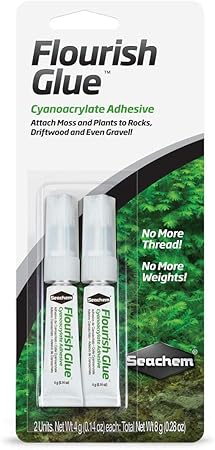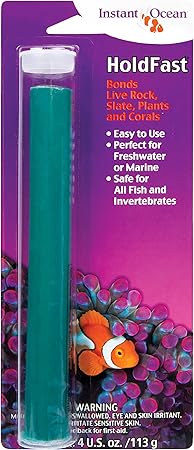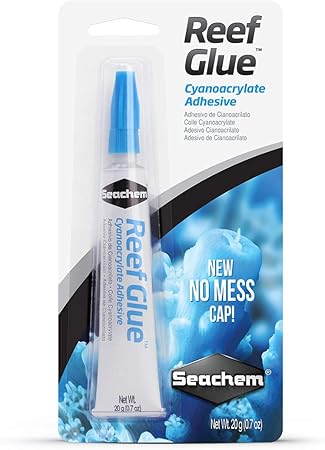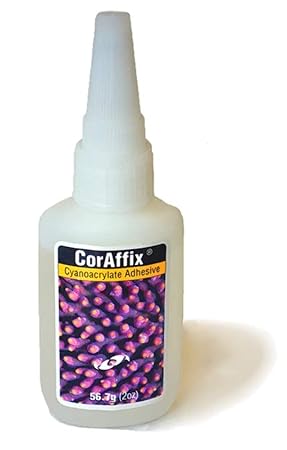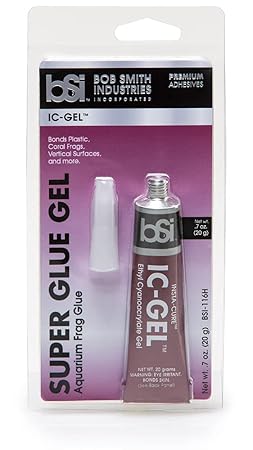The use of adhesives in freshwater and marine aquariums is now a common practice.
You may be wondering why someone would use glue in their tank. There are many reasons!
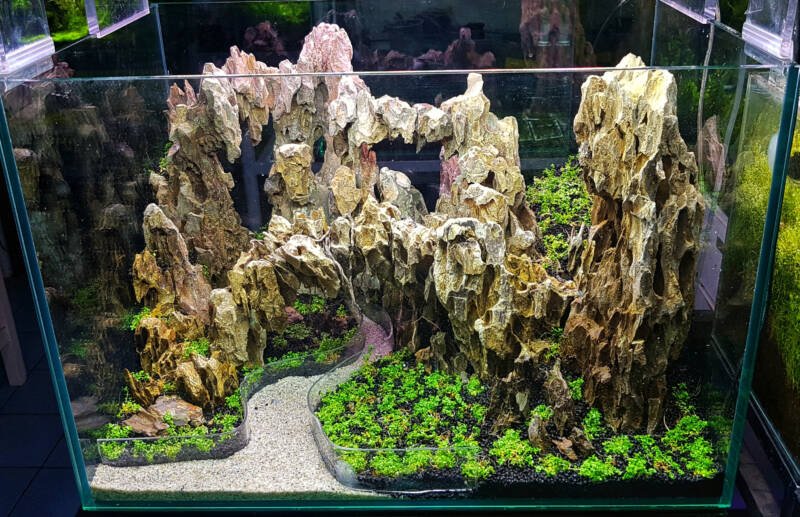
Here’s a list of common uses of underwater adhesives:
- Building rock walls and caves in freshwater aquariums;
- Cementing reef rock together in saltwater aquariums;
- Attaching coral frags to pedestals or live rock;
- Attaching aquatic plants and moss to driftwood and rocks.
In this article
Is it safe to use glue in an aquarium?
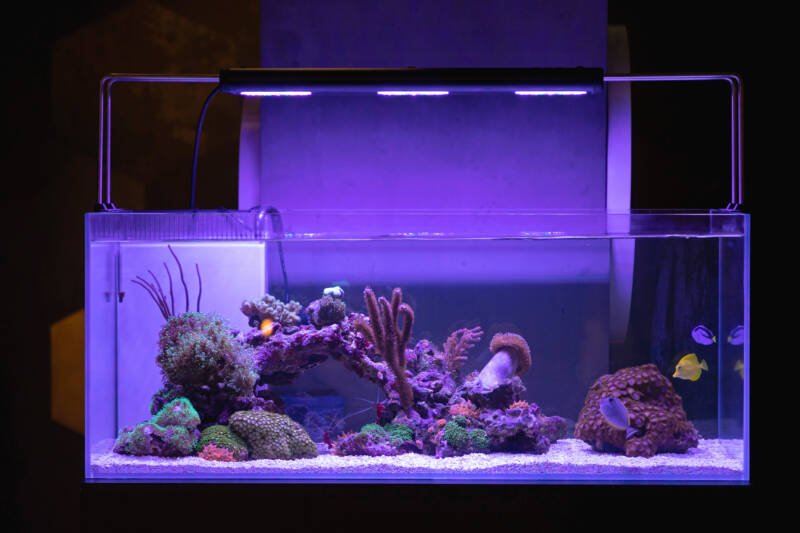
Not all glues and adhesives can be used in an aquarium.
The primary reason is most won’t work very well when submerged under water. Water-based glue will soften and dissolve in water.
Safety for fish, plants, and invertebrates is another concern. However, years of testing and experimentation have provided aquarists with several types of aquarium-safe glues and adhesives that work under water.
Types of Aquarium Glue
Silicone
The most-used adhesive is silicone. Glass aquariums are held together and sealed with a thin layer of silicone-like sealant.
Silicone-based adhesives will seal the gap in between the glass and remain flexible. The glass panels actually move a little when you change water or scrape the glass.
For gluing plastic plants to a rock or assembling a few small rocks together, a consumer-grade 100% silicone sealer will do the job, but it tends to look messy.
In general, most silicone products sold for aquarium use are weak adhesives. The bond is not very strong but works for stabilizing a small rock cave or attaching plastic plants to a piece of rock.
The gloppy silicone is not the best choice for aquascaping. Silicone sealants must be applied to dry surfaces. They also take about 24 hours to cure completely.
Once fully cured, the sealant can be submerged in water. If the silicone is not cured, it will turn jelly-like in the aquarium.
Hot Glue
Hot glue has been used to piece together small ornaments, plastic rock shelves, and other lightweight materials.
Hot glue won’t stick to wet surfaces. Hot glue dries quickly, making it ideal if you want to quickly assemble a small decoration.
It is water resistant but will eventually become brittle under water. You would not use hot glue to hold anything heavy together.
It is not recommended for gluing rock together or for fragging.
Super Glue
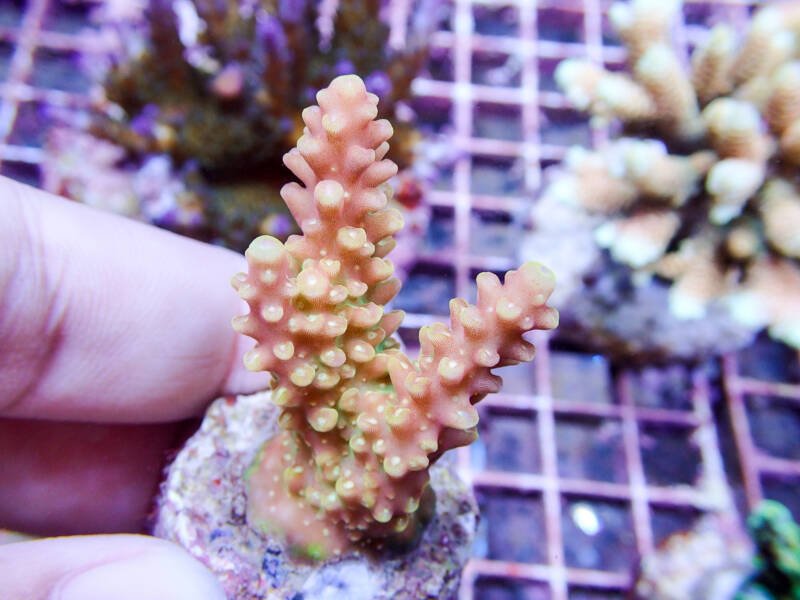
Just about everyone has used super glue to fix something around the house. The basic ingredient is cyanoacrylate.
In gel form, it is a very useful adhesive in freshwater and marine tanks. The curing of the glue speeds up in the water!
You can use it to bond moss and plants to driftwood and rocks.
It’s also popular with coral fragging. This adhesive will bond the corals to fragging pedestals or to live rock.
It can be applied to plants and corals and instantly submerged into the aquarium.
Two-Part Epoxy
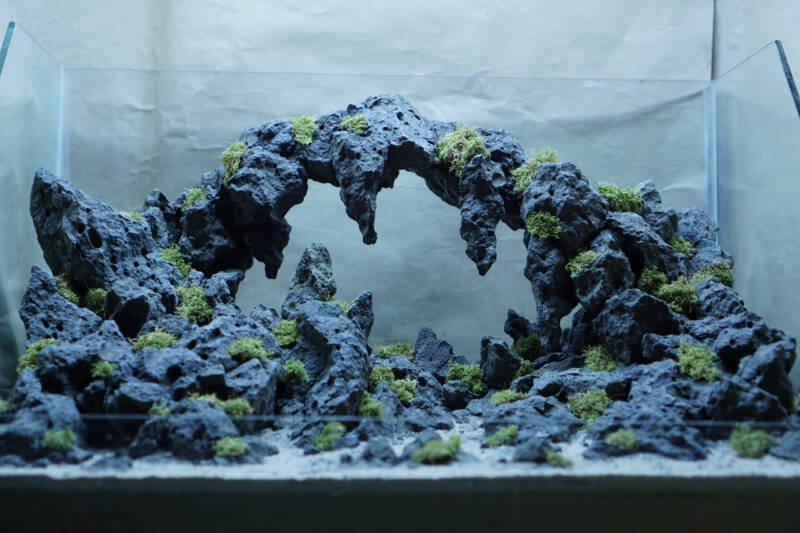
Two-part aquarium epoxy requires you to mix two putty-like materials before use. Once blended together, you’ll have about seven minutes to assemble your project.
Epoxy will permanently bond pieces of rock together. Dried epoxy is rock-hard when fully cured. Most epoxies dry to a white color.
Experienced aquascapers recommend using epoxy on dry pieces of rock for best bonding results.
It will stick when applied underwater, but the bond is weaker. Reef aquarists will see excess foaming of the protein skimmer when applied underwater.
Tips for building a rock aquascape
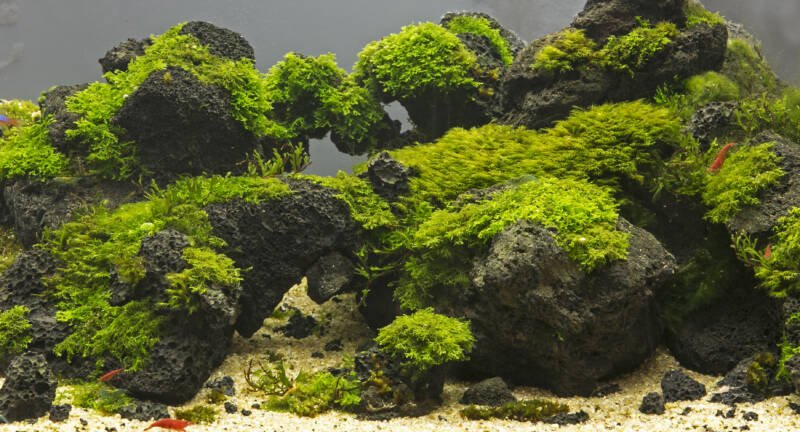
- Test-assemble the rocks to make sure they fit together. Chip off uneven spots if necessary.
- Make sure the final structure fits into the aquarium and allows space on all sides for algae scraping.
- Rocks must be free of loose material and completely dry.
- Follow the mixing and curing instructions on the adhesive.
- For large rock structures, it is recommended to build two small ones and join them inside the aquarium.
Flourish Glue is a thick gel formula cyanoacrylate glue. The main use is for attaching moss and plants to rocks and driftwood.
The glue can be used to bond gravel to rootless stem plants. This creates a weight that helps keep the plants in place until roots form.
Flourish glue bonds within seconds, even under water. The glue can be used in saltwater aquariums to attach frags to rock.
Flourish glue comes in an aluminum tube for a long shelf life.
This two-part epoxy is a fast-curing adhesive that’s safe for marine and freshwater aquariums.
It works well for building rockwork and caves in freshwater and reef aquariums. While some aquarists have used it underwater, it cures best outside of the aquarium.
Curing it in a reef aquarium will cause the protein skimmer to produce excess foam for a while. It dries to a white color, so put the epoxy where it won’t be seen.
Seachem Reef Glue is a thick gel formula cyanoacrylate glue. The main use for Reef Glue is to attach frags to rock.
Reef Glue is applied to the frag and immediately submerged into the aquarium for placement on the rock. Water speeds the curing process.
This glue does not cause the skimmer to foam. Reef Glue is packaged in an aluminum tube for long shelf life.
This reef glue is made from ethyl cyanoacrylate. It is applied to coral frags for bonding on live rock.
The glue can immediately be submerged, where it cures without making excess foam in the protein skimmer. It dries clear.
Coraffix is compatible with two-part epoxies. Some coral fraggers like to apply Coraffix to 2-part epoxy to help hold the frag in place while the epoxy hardens.
Generic super glue gel has been used for many years in freshwater and marine aquariums. The thick gel can be used to attach freshwater plants to stone, rock, and driftwood.
Super Glue gel works for coral fragging too.
Gel forms are easier to use. While they do not come with aquarium-specific instructions, generic super glues work in the same way. Simply apply to the materials you want to bond and set them in place.
IC-GEL is a cyanoacrylate paste that is extremely thick, like toothpaste. The tube’s applicator nozzle makes it easy to apply.
Bob Smith IC-GEL is popular with coral fraggers but can be used with freshwater plants as well.
You can also use IC-GEL to make repairs to plastic ornaments and join plastic rock and caves. Bob Smith IC-Gel has a 3-year shelf life.
Recommendations
For attaching freshwater plants to driftwood and rocks, a thick gel like Seachem Flourish Glue is recommended. It dries clear and is easy to apply.
If you’re building an aquascape using dry reef rock or creating a freshwater rock wall, a two-part epoxy like Instant Ocean Epoxy will provide strong, long-lasting adhesive power to your rock work.
While fraggers use everything from generic super glue to specialty paste like Bob Smith IC-Gel, you’ll have to experiment to see which formula works best on your reef.
